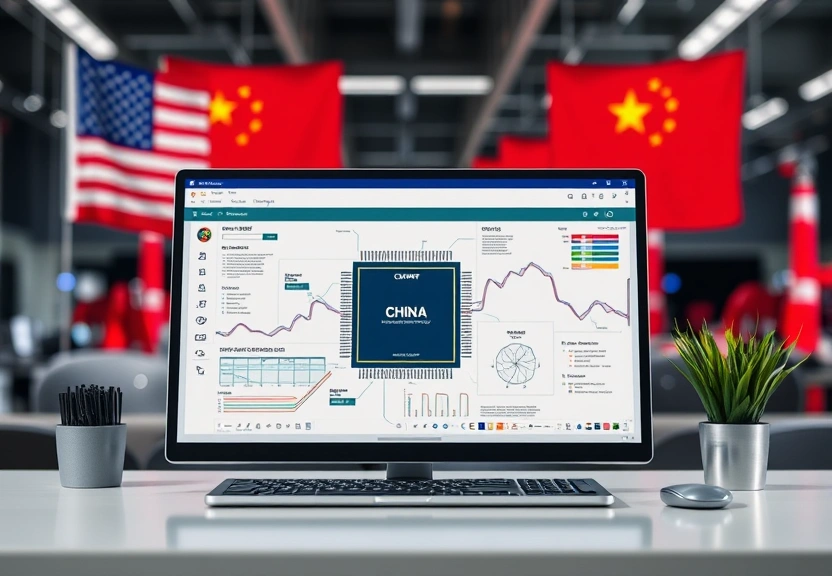Chip-Design Software Stocks Surge as U.S.-China Trade Deal Eases Export Controls
The ongoing tensions between the United States and China have significantly impacted various sectors, particularly technology. Recently, the U.S. government announced an easing of export controls that have been hampering the sales and business operations of major chip-design software companies in China. As a result, stocks for leading firms such as Siemens, Synopsys, and Cadence have surged, reflecting optimism in the semiconductor industry. This article delves deep into how these developments are reshaping the landscape for chip-design software stocks and what it means for the future of technology and trade.

With the lifting of these export restrictions, companies that specialize in software for semiconductor design are poised for substantial growth. This shift is particularly significant given the increasing demand for chips in various applications, from consumer electronics to automotive and artificial intelligence. The easing of trade barriers may not only enhance the financial performance of these companies but also catalyze innovation and collaboration in the chip-design sector.
Understanding the Impact of Export Controls
Export controls have been a contentious issue, particularly in the context of U.S.-China relations. The restrictions were initially imposed to protect national security, but they inadvertently stifled growth and innovation in the semiconductor industry. The recent announcement from the U.S. government has lifted many of these restrictions, allowing for greater collaboration between American companies and their Chinese counterparts.
What Are Export Controls?
Export controls are regulations that governments impose to restrict the export of certain goods and technologies to specific countries. In this case, the U.S. had implemented export controls on chip-design software, which is crucial for creating the integrated circuits that power modern technology. These controls limited the ability of companies like Siemens, Synopsys, and Cadence to conduct business in China, a major market for semiconductor technology.
Reasons for Easing Export Controls
The decision to ease export controls comes after extensive negotiations and a recognition of the importance of the semiconductor industry for both countries. Some of the key reasons include:
- Global Supply Chain Resilience: Strengthening ties with China can help stabilize the global supply chain for semiconductors.
- Increased Demand: The surge in demand for chips in various applications necessitates a collaborative approach.
- Technological Advancements: Easing restrictions can accelerate innovation in chip design and production.
Stock Market Reaction: A Surge in Chip-Design Software Stocks
The easing of export controls has led to a notable rally in the stock prices of major firms in the chip-design software space. Siemens, Synopsys, and Cadence have all reported significant increases in their stock values as investors react positively to the news.
Siemens: A Leader in Chip-Design Software
Siemens, a global powerhouse in engineering and technology, has a robust portfolio of chip-design software that is now more accessible to the Chinese market. With the lifting of export controls, Siemens is expected to expand its customer base in China, leading to increased revenue and market share.
Synopsys: Driving Innovation in Semiconductor Design
Synopsys specializes in electronic design automation (EDA) software, which is crucial for semiconductor design and verification. The company has been at the forefront of innovation in this field, and the easing of restrictions will likely enhance its growth prospects in one of the world’s largest markets for technology.
Cadence: Enhancing Design Efficiency
Cadence is another key player in the chip-design software market, focusing on improving design efficiency and productivity. With the ability to engage more freely with Chinese businesses, Cadence stands to benefit from increased sales and partnerships, ultimately boosting its stock performance.
The Future of Chip-Design Software in a Global Context
The recent developments in U.S.-China trade relations have broader implications for the chip-design software industry and the global technology landscape. As companies navigate these changes, several trends are likely to emerge.
Increased Collaboration and Innovation
With fewer restrictions, collaboration between U.S. and Chinese firms may lead to accelerated innovation in chip design. Joint ventures and partnerships could pave the way for new technologies and improvements in semiconductor manufacturing processes.
Market Expansion Opportunities
For companies like Siemens, Synopsys, and Cadence, the Chinese market represents a significant opportunity. As demand for advanced chips continues to grow, these firms can capitalize on the expanding market, potentially leading to increased revenues and profitability.
Challenges Ahead for Chip-Design Software Companies
While the lifting of export controls presents numerous opportunities, challenges remain for chip-design software companies. These include:
- Geopolitical Risks: Ongoing U.S.-China tensions could lead to future restrictions, impacting business operations.
- Competition: Increased competition from domestic Chinese firms could challenge the market share of U.S. companies.
- Regulatory Changes: Companies must navigate a complex regulatory environment that may evolve in response to geopolitical events.
Frequently Asked Questions (FAQ)
1. What are chip-design software stocks?
Chip-design software stocks refer to shares in companies that develop software used for designing semiconductor chips. This includes companies like Siemens, Synopsys, and Cadence.
2. How do export controls affect the chip-design industry?
Export controls restrict companies from selling their technology to certain countries, limiting their market opportunities and potential for growth.
3. Why did the U.S. lift export controls on chip-design software?
The U.S. lifted export controls to enhance collaboration, stabilize the global supply chain, and meet the increasing demand for semiconductor technology.
4. What impact will this have on Siemens, Synopsys, and Cadence?
The easing of restrictions is expected to boost sales and stock prices for these companies as they expand their operations in China.
5. What are the future prospects for the chip-design software industry?
With increased collaboration and innovation opportunities, the chip-design software industry is poised for growth, although challenges such as geopolitical risks remain.
Conclusion
The recent easing of export controls by the U.S. government represents a significant turning point for the chip-design software industry, particularly for companies like Siemens, Synopsys, and Cadence. As the market responds positively to these developments, the potential for growth and innovation in semiconductor design becomes increasingly evident. However, companies must remain vigilant and adaptable to navigate the challenges and opportunities that lie ahead in a rapidly evolving global landscape.
📰 Original Source
Este artigo foi baseado em informações de: https://www.marketwatch.com/story/these-chip-design-software-stocks-are-climbing-after-a-u-s-china-trade-deal-041b8177?mod=mw_rss_topstories


